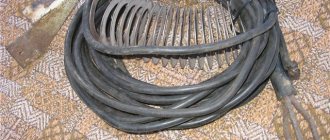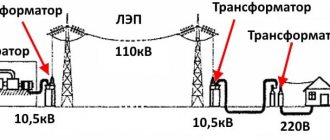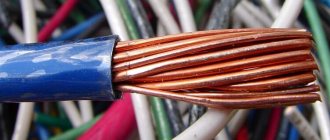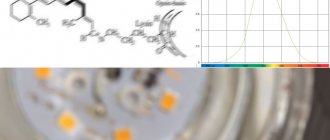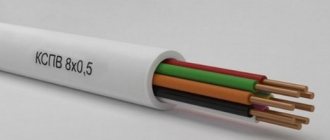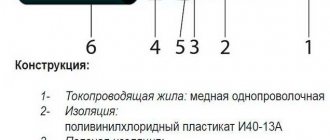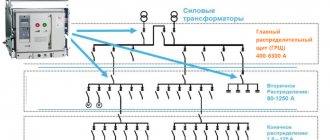"01" December 2022
TYPES OF DEVICES
To protect electrical equipment (electrical installations) and electrical lines, from power lines to home wiring, various types of devices are used, differing:
- purpose;
- operating principle;
- design.
The protection action can be aimed at preventing the failure of electrical equipment (line) or preventing the consequences of an already occurring malfunction.
As an example for the first case, we can cite a device such as a voltage relay, which turns off electrical equipment when the mains voltage goes beyond the established limits, both in the direction of increase and decrease.
In the second, it will be an automatic switch that turns off the electrical wiring if a short circuit occurs.
Other types of equipment under consideration provide protection of human life and health, for example, from electric shock. These are residual current devices (RCDs) and automatic circuit breakers. The latter, by the way, protect both from short circuits and overcurrents.
Basic requirements for devices
In order for the device to be successfully operated, it must meet the following requirements:
- In no case should protection devices have a temperature exceeding that permissible for them under normal load of the electrical network or electrical equipment.
- The device should not disconnect the equipment from the power supply during short-term overloads, which often include inrush current, self-starting current, etc.
When choosing fuse links for fuses, it is necessary to base the rated current in the section of the circuit that will protect the device. This rule for choosing protective devices is relevant in any case when choosing any device for protection. It is also important to understand that with prolonged overheating, the protective qualities are significantly reduced. This has a negative impact on the devices, since at the moment of critical load they may, for example, simply not turn off, which will lead to an accident.
Protection devices must necessarily turn off the network when prolonged overloads occur within this circuit. In this case, the inverse dependence on the current with respect to the holding time must be observed.
In any case, the protective device must disconnect the circuit at the end when a short circuit (short circuit) occurs. If a short circuit occurs in a single-phase circuit, then the shutdown must occur in a network with a solidly grounded neutral. If a short circuit occurs in a two-phase circuit, then in a network with an isolated neutral.
Electrical circuit protection devices have a breaking capacity of I pr. The value of this parameter must correspond to the short circuit current that may occur at the beginning of the protected section. If this value is lower than the maximum possible short-circuit current, then the process of disconnecting a section of the circuit may not occur at all or may occur, but with a delay. Because of this, not only the devices connected to this network can be damaged, but also the electrical circuit protection device itself. For this reason, the breaking capacity factor must be greater than or equal to the maximum short-circuit current.
Efficiency of surge protection devices
To summarize, we can say that the surge protector and RKN provide only partial protection and do not cope with the entire range of network problems. The voltage stabilizer and UPS are more universal - the equipment connected to them is less accessible to negative network influences (if you additionally install an SPD in front of the stabilizer or UPS, the level of protection will increase even more).
However, not all stabilizers and UPS are of high quality and truly reliable, so you should be as careful as possible when choosing a device and consult with professionals if any questions arise.
It is worth noting that the average cost of a high-quality UPS exceeds the cost of a stabilizer of similar power and quality (with approximately the same functionality for combating network surges).
Fuses
Today there are several devices for protecting electrical networks, which are the most common. One such device is a fuse. The purpose of a protection device of this type is that it protects the network from current overloads and short circuits.
Today, there are devices for one-time use, as well as with replaceable inserts. Such devices can be used both for industrial needs and in everyday life. For this purpose, there are devices that are used in lines up to 1 kV.
In addition to them, there are high-voltage devices used at substations whose voltage is more than 1000 V. An example of such a device would be a fuse on auxiliary transformers of substations with 6/0.4 kV.
Since the purpose of these protection devices is to protect against short circuits and current overloads, they are widely used. In addition, they are very simple and easy to use, their replacement is also quick and easy, and they themselves are very reliable. All this has led to the fact that such fuses are used very often.
To review the technical characteristics, you can take the PR-2 device. Depending on the rated current, this device is available with six types of cartridges, which differ in diameter. In the cartridge of each of them, an insert can be installed with the expectation of a different rated current. For example, a cartridge designed for a current of 15 A can be equipped with an insert for both 6 A and 10 A.
In addition to this characteristic, there is also the concept of lower and upper test current. As for the lower value of the test current, this is the maximum value of current, when flowing in the circuit for 1 hour, a section of the circuit will not be disconnected. As for the upper value, this is the minimum current coefficient that, when flowing for 1 hour in the circuit, will melt the insert in the protection and control device.
Let's sum it up
Both at home and at work, people periodically have to deal with unstable current behavior in the electrical network.
Voltage surges can damage expensive equipment and also lead to much more serious consequences, such as a fire.
There can be many reasons for this - old wiring, electrician errors, and various external factors.
Therefore, in order to prevent the harmful effects of such fluctuations, it is important to take care of appropriate protection in advance. Choosing the right protective device is the key to your safety.
Circuit breakers
Circuit breakers play a similar role to fuses, but their design is more complex. However, this is compensated by the fact that switches are much more convenient to use than fuses. For example, if a short circuit occurs in the network due to aging insulation, the switch is able to disconnect the damaged section of the electrical circuit from power. At the same time, the control and protection device itself is quite easily restored; after operation it does not require replacement with a new one, and after repair work it is again able to reliably protect the section of the circuit under its control. It is very convenient to use this kind of switches if you need to carry out any routine repair work.
As for the production of these devices, the main indicator is the rated current for which the device is designed. In this regard, there is a huge selection, which allows you to select the most suitable device for each circuit. If we talk about operating voltage, then they, like fuses, are divided into two types: with voltages up to 1 kV and high-voltage with operating voltages above 1 kV. It is important to add here that high-voltage devices for protecting electrical equipment and electrical circuits are produced vacuum, with inert gas or oil-filled. This design allows the chain to be released at a higher level when the need arises. Another significant difference between circuit breakers and fuses is that they are manufactured for operation not only in single-phase, but also in three-phase circuits.
For example, if a short circuit to ground occurs in one of the cores of an electric motor, the circuit breaker will turn off all three phases, and not just the damaged one. This is a significant and key difference, since if only one phase is turned off, the motor will continue to operate on two phases. This mode of operation is emergency and greatly reduces the service life of the device, and can even lead to emergency failure of the equipment. In addition, automatic type switches are manufactured to operate with both alternating and direct voltage.
Electrical equipment protection degree
Electrical equipment such as distribution boards, sockets, lamps, switches, etc. can be located in different places and in any room.
For example, on the street, in the garage, in the bathroom, in dusty warehouses, etc. In all of these places there are various external factors that can have a negative impact on the operation of electrical equipment. This is rain outside, high humidity in the bathroom, dust in the warehouse, etc. Therefore, not any sockets can be installed in the bathroom, but only waterproof ones. Such electrical equipment is classified according to the level of protection of the shell (casing) from the penetration of solids and water. You need to know and be able to determine this degree of protection in order to choose the right distribution board, sockets, switches, etc. If you neglect this parameter, then if you make the wrong choice, there may be a high probability of water, dust and other debris getting into operating electrical equipment. Which will certainly lead to its failure.
What is the degree of protection of electrical equipment?
“The degree of protection means the method of protection, verified by standard test methods, which is provided by the enclosure against access to hazardous parts (dangerous live and dangerous mechanical parts), the ingress of external solid objects and (or) water into the enclosure.”
There is such an international classification system as Ingress Protection Rating. It is designated in the form of the letters IP and two numbers after them, for example, IP20. You can find this designation on the body of the device itself or in its passport. Let's look below at what degrees of protection exist in this international classification.
Protection against penetration of foreign solid objects.
The first number after the letters IP indicates the level of protection of the housing from accidental ingress of any solid substances, parts of a person’s body or an object in his hands. There are classes from 0 to 6. For a detailed explanation, see the table below.
| Protection level | Size (diameter) of foreign objects, mm | Description |
| – | No protection whatsoever | |
| 1 | More than 50 | The shell (body) provides protection against access to large parts of the human body (back of the hand, etc.). No protection from conscious contact |
| 2 | Up to 12.5 | Provides protection against accidental penetration by fingers and similar objects |
| 3 | Up to 2.5 | Provides protection against accidental penetration of tools, cables and other similar objects |
| 4 | Up to 1 | Provides protection against accidental penetration of wires, bolts and similar objects |
| 5 | Dustproof | Provides complete protection against accidental contact. However, a small amount of dust may get inside, which does not affect the operation of electrical equipment. |
| 6 | Dustproof | Provides complete protection against accidental contact and dust ingress |
Protection against water penetration.
The second number after the letters IP indicates the level of protection of the housing from accidental ingress of water, which damages electrical equipment. There are classes from 0 to 8. For a detailed explanation, see the table below.
| Protection level | Defence from. | Description |
| – | No protection whatsoever | |
| 1 | Vertical drops | The housing provides protection against vertical drops of water |
| 2 | Vertical drops at an angle up to 15 0 C | The device body provides protection against vertical drops of water if it is tilted up to 15 0 C from the working position |
| 3 | Falling splashes | Protection is provided against vertical drops or at an angle of up to 60 0 C to the vertical of water drops. Protects from rain. |
| 4 | Spray | Protection is provided against splashes falling in any direction, i.e. from special continuous spraying |
| 5 | Jets | Protection against water jets flowing in any direction |
| 6 | Sea waves | Provides protection against strong water jets or sea waves |
| 7 | Short-term immersion to a depth of 1 meter | Provides protection against short-term immersion of electrical equipment in water. Some of the water that manages to get inside does not have a harmful effect on its operation. Continuous operation while immersed in water is prohibited. |
| 8 | Prolonged immersion in water to a depth of more than 1 meter | There is complete protection against moisture getting under the shell (case). Long-term work under water is possible. |
I think now you will be able to determine from what external factors a specific housing of a switchboard, socket, lamp, etc. can protect.
As an example, below I am posting photos from electrical equipment catalogs of some well-known manufacturers, which indicate the degree of protection of electrical equipment IP.
1. Circuit breakers of the “House” series from Schneider Electric have a protection degree of IP20. This means that its body protects against accidental contact of human fingers with its live parts, but there is no protection against water getting inside. The degree of protection IP40 means that the machines in the modular cabinet are protected from accidental ingress of small objects up to 1 mm.
2. Cabinets of the “Mini Pragma” series from Schneider Electric have IP40 protection, i.e. protect only from small hard objects up to 1 mm in size. They do not provide protection against water ingress.
3. Cabinets for indoor installation of the UK500 series from ABB have a degree of protection of IP30. These cabinets have a housing that protects against accidental penetration of tools, cables and other similar objects, but does not protect against small bolts and similar objects up to 1mm.
4. Below is a cabinet from ABB, which has a protection rating of IP43. Unlike previous cabinets, it is able to protect electrical equipment from rain. It can already be placed outside.
5. Sockets also have different degrees of IP protection. For example, I took an ABB socket with a degree of protection of IP44. It has curtains and a lid. Its body must provide protection against penetration of solid objects up to 1 mm into live parts and splashes falling in any direction.
6. Distribution boxes are also different. Some can be installed outdoors, while others cannot. Below are distribution boxes with degrees of protection IP55 and IP65 from ABB. The first (IP55) provides complete protection against accidental contact and partially against dust and water jets flowing in any direction. The second (IP65) is completely dustproof.
7. It is worth noting devices that have two degrees of protection. For example, sockets that have a protective cover. In the version shown in the photo, in a closed state (without a plug), it has a protection class of IP44, and in an open state (with a plug inserted) it is already IP20. This is also worth taking into account, since such an outlet cannot be used everywhere and not always.
Have you ever paid attention to the IP protection level when purchasing electrical equipment? Write in the comments.
A teacher says to a student during a labor lesson: “You strike with a hammer like lightning.” – Are you saying that I work so fast? - No. It's just that lightning never hits the same place twice.
Source: sam-sebe-electric.ru
Thermal and current relay
Today, among electrical network protection devices there are many different types of relays.
A thermal relay is one of the most common devices that can protect electric motors, heaters, and any power devices from problems such as overload current. The operating principle of this device is very simple, and it is based on the fact that electric current is capable of heating the conductor through which it flows. The main working part of any thermal relay is a bimetallic plate. When heated to a certain temperature, this plate bends, which breaks the electrical contact in the circuit. Naturally, the plate will heat up until it reaches a critical point.
In addition to thermal ones, there are other types of protection devices, for example a current relay, which controls the amount of current in the network. There is also a voltage relay that will respond to changes in voltage in the network and a differential current relay. The last device is a leakage current protection device. It is important to note here that circuit breakers, like fuses, cannot react to the occurrence of current leakage, since this value is quite small. But at the same time, this value is quite enough to kill a person upon contact with the body of a device susceptible to such a malfunction.
If there are a large number of electrical devices that need to be connected to a differential current relay, then combined circuit breakers are often used to reduce the size of the power panel. Such devices are devices that combine a circuit breaker and a differential current relay - differential protection circuit breakers, or differential circuit breakers. When using such devices, not only the size of the power shield is reduced, but also the process of installing the protection device is greatly simplified, which, in turn, makes them more economical.
Our response to Chamberlain
In the era of a market economy, despite even the “gaps” in the PUE, there is no shortage of supply of mains voltage control relays. Moreover, both foreign and domestic manufacturers are represented on the market. The consumer inevitably faces the question of what parameters should be used to select a relay. On the one hand, it should become a reliable barrier to the path of poor-quality energy from the power grid to the load. On the other hand, be reliable and inexpensive.
The main criteria characterizing the operation of relays should be their versatility and functionality .
Relays must be digital, since implementing complex logic of action, accuracy and reliability is possible only on the basis of microprocessor technology.
Decisions on going beyond the controlled parameters should be made based on the current or close to it average voltage value over the period. Operating on peak voltage values leads to false alarms.
The presence of a wide range of adjustable settings is also an undoubted advantage of the relay.
The relay power supply circuit must be organized from the most measured voltage, from 3 phases simultaneously for a 3-phase relay, in order to maintain information content in the presence of at least one phase.
The presence of a simple and logical indication, the degree of protection and climate, this is, perhaps, the entire list of main parameters by which a comparative analysis of voltage relays can be made.
Characteristics of thermal relay
The main characteristic for thermal relays is the response time, which depends on the load current. In other words, this characteristic is called time-current. If we consider the general case, then before the load is applied, current I0 will flow through the relay. In this case, the heating of the bimetallic plate will be q0. When checking this characteristic, it is very important to consider from what state (overheated or cold) the device is triggered. In addition, when testing these devices, it is very important to remember that the plate is not thermally stable when a short circuit current occurs.
Thermal relays are selected as follows. The rated current of such a protective device is selected based on the rated load of the electric motor. The selected relay current should be 1.2-1.3 of the rated motor current (load current). In other words, such a device will work if the load is between 20 and 30% within 20 minutes.
It is very important to understand that the operation of the thermal relay is significantly influenced by the ambient air temperature. Due to an increase in ambient temperature, the operating current of this device will decrease. If this indicator differs too much from the nominal value, then it will be necessary to either carry out additional smooth adjustment of the relay, or buy a new device, but taking into account the actual ambient temperature in the working area of this unit.
To reduce the influence of ambient temperature on the magnitude of the current operation, it is necessary to purchase a relay with a large rated load value. In order to achieve proper functioning of the warm device, it should be installed in the same room in which the controlled object is located. However, you need to remember that the relay reacts to temperature, and therefore it is prohibited to place it near concentrated heat sources. Such sources are considered to be boilers, heating sources and other similar systems and devices.
IP decryption table
In the characteristics of the equipment there is a line “protection class” and it costs IP 44, IP 20, IP 61, IP 37, etc. To understand what this equipment is protected from, you need to know what these numbers mean.
From this table it is easy to understand what exactly this IP means
Decoding the first digit
The first digit in the code describing the security class indicates the degree of protection against the impact of solid objects of different sizes, as well as the degree of protection against penetration into the housing:
0 — absence of any protection;
1 - protects against penetration of objects with a diameter of more than 50 mm (simply covers from contact with the electrically conductive part);
2 - protection from objects with a diameter of 12 mm or more (from fingers, branches, etc.);
3 - objects larger than 2.5 mm cannot penetrate (some tools, cables, etc.);
4 - only objects smaller than 1 mm in size can be hit (very small fasteners, thin wires, etc.);
5 - complete protection from contact, dustproof shell (a small amount of dust can get inside, but it does not affect the work);
6 - the highest degree of protection from dust, dust-proof shell (even dust does not penetrate).
How the tests are carried out
Knowing the values listed above, it is easy to understand what the body of each specific product can protect from. For example, an ordinary household switch has a protection class of IP 20, that is, its housing is guaranteed to protect against finger contact with electrical parts.
This is how the degree of IP protection is presented in the product descriptions
Sometimes in the installation requirements you can see this option: IPx6, IPx4 or any other number in second place. If there is an "x" in place of the first digit, this means that the requirements for protection against dust and contact are not defined, and in this part you can select equipment based on your own requirements.
Decoding the second digit
The second digit of the IP protection class shows how much the case protects the contents from moisture. The numbers usually range from 0 to 7, but European manufacturers also have 8 and 9. Here’s what all these numbers mean:
0 - no protection from moisture;
1—vertically falling drops on the housing do not disrupt the operation of the device;
2 - if the housing is tilted at an angle of 15°, vertically falling drops do not disrupt the operation of the device;
3 — protection from splashes falling at an angle of up to 60° (from rain);
4 - splashes of water from any direction are not scary (can be placed in bathrooms at a distance of 20 cm from the water source and closer);
Example of testing the degree of protection against jets of water
5 - water jets do not cause harm (any angle of inclination);
6 — the housing is able to withstand waves and jets of water (entered water does not interfere with the operation of the equipment);
7 - with a short-term immersion of 1 meter in water, the device continues to work;
8 - if you stay at a depth of 1 meter for a long time, the device works;
9 - complete waterproofness, the device operates under water for a long time.
Knowing the decoding of the second digit of the code, you can easily determine for what conditions specific equipment can be used. For example, for outdoor installation, the housing must protect the contents from rain. That is, when installing outdoors, we take equipment whose second digit of the IP code is at least 4.
Brief description of the meaning of the numbers in the IP protection degree code
Some instructions contain requirements for the equipment protection class in the form of IP 3x or IP8x, etc. This means that the requirements for the degree of protection against moisture are not defined and are selected independently.
Additional characters
Additional symbols in the code for indicating the degree of protection of electrical equipment IP are not always used. They are usually present in cases where the actual degree of protection is somewhat greater than that specified in the code. There’s just a limited number of codes; it’s possible to more accurately describe what exactly this case or shell protects against only by using these additional symbols.
In addition to the required symbols - two numbers, there can also be letters
Immediately after the numbers there may be Latin letters A, B, C, D. They indicate additional protection against contact with live parts of the equipment:
A - back of the hand;
Meaning of letters in IP protection degree coding
The second position may contain the letters H, M, S, W. They encrypt different characteristics.
H - high-voltage equipment (you won’t find it among household appliances and equipment);
M - the device worked during water protection tests;
S—disabled during testing;
W - the housing or shell protects against weather influences.
These letters are placed only if the containment satisfies all lower requirements. That is, if there is a letter C, then you will not be able to crawl either with a tool, or with the back of your hand, or with a finger.
Device selection
When choosing equipment to protect electrical receivers and electrical networks, it is necessary to base it on the rated currents for which these devices are designed, as well as on the current supplying the network where such units will be installed.
When choosing a protective device, it is very important to keep in mind the occurrence of such abnormal operating modes as:
- short circuits of phase-to-phase type;
- phase short circuit to housing;
- a strong increase in current, which can be caused by an incomplete short circuit or overload of process equipment;
- complete disappearance or too much reduction in voltage.
As for short circuit protection, it must be carried out for all electrical receivers. The main requirement is that disconnecting the device from the network when a short circuit occurs should be the minimum possible. When choosing protective devices, it is also important to know that full overcurrent protection must be provided, with the exception of the following few cases:
- when overloading electrical receivers for technological reasons is simply impossible or unlikely;
- if the power of the electric motor is less than 1 kW.
In addition, the electrical installation protection device may not have an overload protection function if it is installed to monitor an electric motor that is operated in short-term or intermittent mode. An exception is the installation of any electrical appliances in rooms with a high fire hazard. In such premises, overload protection must be installed on all devices without exception.
Undervoltage protection must be installed in a number of the following cases:
- for electric motors that cannot be connected to the network at full voltage;
- for electric motors in which self-starting is not allowed for a number of technological reasons, or it is dangerous for employees;
- for any other electric motors, the power off of which is necessary in order to reduce the total power of all connected electrical receivers in this network to an acceptable value.
Permissible deviations of mains voltage according to GOST
The standard voltage level of a single-phase electrical network in our country is 230 V - this is the nominal value that all modern household appliances are designed for. According to the requirements of GOST 29322-2014 (IEC 60038:2009), which defines power quality standards, the discrepancy with this value should not exceed ±10%. Thus, in relation to a single-phase home network, the maximum permissible voltage range is 207-253 V.
Extreme values from this range, not to mention large deviations, have a detrimental effect on many modern electrical appliances, especially those that do not include a switching power supply. It should be understood that malfunction of household appliances caused by poor-quality power supply will not be considered a warranty case - the manufacturer, as a rule, stipulates such situations as follows: “The warranty does not apply to a product that fails due to increased/lowered input voltage.”
Types of currents and selection of protective devices
The most dangerous is short circuit current. The main danger is that it is much higher than the normal inrush current, and its value can vary greatly depending on the section of the circuit where it occurs. Thus, when checking a protective device that protects a circuit from a short circuit, it must disconnect the circuit as quickly as possible when such a problem occurs. Moreover, in no case should it be triggered when a normal value of the starting current of any electrical device occurs in the circuit.
As for the overload current, everything is quite clear here. Such current is considered to be any characteristic value that exceeds the rated current of the electric motor. But here it is very important to understand that not every time an overload current occurs, the protective device must disconnect the circuit contacts. This is also important because short-term overload of both the electric motor and the electrical network is acceptable in some cases. It is worth adding here that the more short-term the load, the greater values it can reach. Based on this, it becomes clear what the main advantage of some devices is. The degree of protection of devices with a “dependent characteristic” in this case is maximum, since their response time will decrease with increasing load factor at this moment. Thus, such devices are ideal for overcurrent protection.
To summarize briefly, we can say the following. For short-circuit protection, a fast-moving device must be selected, which will be configured to operate at a current that is significantly higher than the starting value. To protect against overload, on the contrary, the protection switching device must have inertia, as well as a dependent characteristic. It must be selected in such a way that it does not operate while the electrical device is normally starting.
Digital or analog
Now the era of analog devices, if not completely over, is at the end stage.
Analog devices are being replaced by digital microprocessor devices. Today it has become possible to use microprocessors to create devices with logic of almost any complexity. Much has been said about the advantages of digital technology, including in relation to protective devices, and no one doubts the clear advantages of new generation technology over analog devices. But not everyone can produce cheap products yet.
Truly digital microprocessor devices with a wide range of protective functions and complex operating logic for wide consumption, i.e. low in price, few can create. Proof of this can be the exposition of any specialized exhibition, catalogs of foreign and domestic manufacturers, etc.
Disadvantages of different types of protective devices
Fuses, which were previously widely used as devices for protecting switchgear, have the following number of disadvantages:
- rather limited possibility for use as protection against overload current, since detuning from inrush currents is quite complicated;
- the electric motor will continue to operate on two phases, even if the third is cut off by the fuse, which is why the motor often fails;
- in certain cases the cut-off power limit is insufficient;
- There is no way to quickly restore power supply after a power outage.
As for air type circuit breakers, they are more advanced than fuses, but they are not without drawbacks. The main problem with using electrical protective devices is that they are not selective in terms of action. This is especially noticeable if an unregulated cut-off current occurs at the installation machine.
There are automatic installation machines in which overload protection is carried out using thermal releases. Their sensitivity and delay are worse than those of thermal relays, but at the same time they act on all three phases at once. As for universal automatic machines for protection, here it is even worse. This is justified by the fact that only electromagnetic releases are available.
Magnetic starters with built-in thermal relays are often used. Such protective equipment is capable of protecting an electrical circuit from overload current in two phases. But since thermal relays have a large inertia, they are not able to provide protection against short circuits. If you install a holding coil in the starter, you can provide undervoltage protection.
High-quality protection from both overload current and short circuit can only be provided by inductive relays or electromagnetic relays. However, they can only operate through a disconnecting device, which makes their connection circuit more complex.
To briefly summarize the above, we can draw the following two conclusions:
- To protect electric motors, whose power does not exceed 55 kW, from overload current, magnetic starters with fuses or with air devices are most often used.
- If the power of the electric motor is more than 55 kW, then electromagnetic contactors with air devices or protective relays are used to protect them. It is very important to remember here that the contactor will not allow the circuit to break if a short circuit occurs.
When selecting the right device, it is very important to calculate the protection devices. The most important formula is the calculation of the rated current of the motor, which will allow you to select a protective device with suitable indicators. The formula looks like this:
Iн=Рдв ÷(√3*Un*cos c*n), where:
Iн is the rated current of the motor, which will have the dimension in A;
Rdv is the engine power, which is represented in kW;
Un is the rated voltage in V;
cos c is the active power factor;
n is the efficiency factor.
Knowing these data, you can easily calculate the rated current of the motor, and then easily select a protective device suitable for its intended purpose.
The most common protection classes and their scope
Despite the fact that theoretically there can be any combination of degrees of protection, certain classes are most common. A description of the possible area of their use will be given in this paragraph.
- IP 20 . The devices are intended for use in heated rooms with normal humidity levels. They provide a sufficient level of protection from electricity, but do not protect from moisture.
- IP 21/22 . The devices can also be used indoors, but without heating, as well as outdoors under canopies.
- IP 43/44 . The equipment can be used in damp areas.
- IP 54/55 . Can be installed outdoors in the open air, withstands rain, snow, and icing.
- IP 67/68 . The equipment can be immersed in water. This class of protection for luminaires is needed to organize pool lighting.
Types of damage to protective equipment
The main difference between means of protecting electrical circuits and other devices is that they not only detect a defect, but also disconnect the circuit if the characteristic values exceed certain limits. The most dangerous problem, which often disables protective equipment, has become a dead short circuit. During the occurrence of such a short circuit, the current indicators reach the highest values.
When a circuit breaks when such a problem occurs, an electric arc often occurs, which in a short period of time is quite capable of destroying the insulation and melting the metal parts of the device.
If too much overload current occurs, it can lead to overheating of conductive parts. In addition, mechanical forces arise that significantly increase the wear of individual elements of the equipment, which can sometimes even lead to breakdown of the device.
There are high-speed switches that are susceptible to problems such as the moving lever and moving contact touching the walls of the arc chamber, as well as shorting the demagnetizing coil busbar to the housing. Quite often there is excessive wear on the contact surfaces, pistons and cylinders of the drives.
conclusions
The time to defend properly has truly come. The growing energy consumption of enterprises and the energy saturation of household consumers lead to an increase in the number of network failures. There is an urgent need to bring the PUE to the norms of international law in this area. These rules should not only regulate the need, place and methods of protection, but also introduce general requirements for devices that protect against mains voltage failures. This will put an end to voluntarism in this area, when each manufacturer imposes its own vision of the problem on the consumer, which is often very far from the ideal. Such a formulation of the question will allow, firstly, to clear the market from the rubble of electronic junk “false protections”, and, secondly, it will clear the way for devices that can reliably, efficiently, and most importantly - correctly , protect the consumer.
Novatek-Electro LLC The full article was published in Electrical Engineering News No. 4, 2004.
Repair of high-speed devices
Repair of any type of high-speed protective device must be performed in the same sequence. The high-speed switch, or BV, is purged with clean compressed air under a pressure of no more than 300 kPa (3 kgf/cm2). After this, the device is wiped with napkins. Next, it is necessary to remove such elements as the arc chute, blocking device, pneumatic drive, armature with moving contact, inductive shunt and others.
Direct repair of the device is carried out at a special repair stand. The arc chamber is disassembled, its walls are cleaned in a special shot blasting unit, after which they are wiped and inspected. Chips may be allowed in the upper part of this chamber if their dimensions do not exceed 50x50 mm. The thickness of the walls at the break points should be from 4 to 8 mm. It is necessary to measure the resistance between the horns of the arc chute. For some samples, the indicator should be at least 5 MOhm, and for some, at least 10 MOhm.
The damaged partition must be cut down along its entire length. All similar areas of log houses must be thoroughly cleaned. After this, the surfaces to be glued are lubricated with an adhesive solution based on epoxy resin. If broken fan sheets are found, they are replaced. If they are bent, they must be straightened and returned to service. There is also an arc extinguishing coil, which must be cleaned of carbon deposits and melts, if any.
IP degree of protection of electrical equipment
Date of publication: 05/08/2019
The IP code classifies and evaluates the degree of protection of electrical equipment from the penetration of solid objects and water. The numbers following the letters IP indicate the degree of security.
The encoding of the degree of protection, according to GOST 14254-2015, is as follows:
- X1 (indicated by a number) displays the level of protection that protects the equipment housing from access to dangerous parts, dust and other large objects;
- X2 (indicated by a number) shows the degree of protection from moisture (drops, splashes, jets of water, etc.).
- A, M are additional code characters describing auxiliary characteristics (optional).
First digit of the IP
Second digit of the IP
lack of any protection
no moisture protection
protects against penetration of objects with a diameter of more than 50 mm (simply covers from contact with the electrically conductive part)
vertically falling drops on the housing do not interfere with the operation of the device
protection from objects with a diameter of 12 mm or more (from fingers, branches, etc.)
If the housing is tilted at an angle of 15°, vertically falling drops do not interfere with the operation of the device
Objects larger than 2.5 mm (some tools, cables, etc.) cannot penetrate.
protection against splashes falling at an angle of up to 60° (from rain)
only objects smaller than 1 mm in size can be hit (very small fasteners, thin wires, etc.)
splashes of water from any direction are not scary (can be placed in bathrooms at a distance of 20 cm from the water source and closer)
complete protection from contact, dustproof shell (a small amount of dust may get inside, but it will not affect the work)
the impact of water jets does not cause harm (any angle of inclination)
highest degree of dust protection, dust-proof shell (even dust does not penetrate)
the housing is able to withstand waves and jets of water (entered water does not interfere with the operation of the equipment)
with a short-term immersion of 1 meter in water, the device continues to work
when staying at a depth of 1 meter for a long time, the device works
Completely waterproof, the device works underwater for a long time
Additional symbols are not always used in the code; they are necessary in cases where the degree of protection is greater than that specified in the code.
Additional sign indicating protection against contact with live parts of equipment
Additional symbol indicating different characteristics
back of hand
high-voltage equipment (you won’t find it among household appliances and equipment)
During water protection tests, the device worked
was disabled during testing
the housing or shell protects against weather influences
PO Premium-Electro LLC produces cable-supporting systems that have different degrees of structural protection. You can obtain more detailed information from the company's managers.
Source: prelektro.ru
Degree of protection according to PUE and GOST
Before installing electrical equipment, it is necessary to find out its degree of protection in accordance with PUE, TU or GOST. In other words, you need to decide, for example, which sockets and lamps are allowed in the bathroom.
The PUE represents the main document for the safe use of electrical equipment. It displays the rules for electrical installations. Hence the abbreviated name PUE. The rules state that:
- the electrical equipment used must comply with GOST or TU;
- the design, method of installation of electrical equipment and characteristics of wire insulation must meet all the requirements of the PUE;
- electrical equipment and structures combined with it must be protected from negative external influences.
So, we’ve sorted out the PUE, and as for other standards, the international index IEC 60529 or GOST 14254-96 precisely indicate the degree of protection, designated IP. This GOST applies to electrical equipment with a voltage not exceeding 72.5 kV. GOST R 51330.20-99 is in force on the territory of the Russian Federation.


